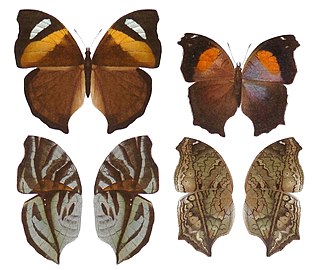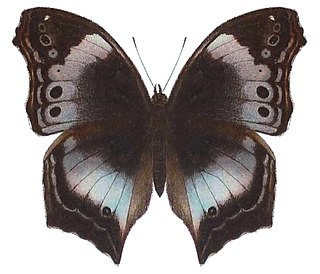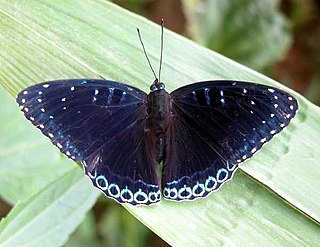
The Nymphalidae are the largest family of butterflies, with more than 6,000 species distributed throughout most of the world. Belonging to the superfamily Papilionoidea, they are usually medium-sized to large butterflies. Most species have a reduced pair of forelegs and many hold their colourful wings flat when resting. They are also called brush-footed butterflies or four-footed butterflies, because they are known to stand on only four legs while the other two are curled up; in some species, these forelegs have a brush-like set of hairs, which gives this family its other common name. Many species are brightly coloured and include popular species such as the emperors, monarch butterfly, admirals, tortoiseshells, and fritillaries. However, the under wings are, in contrast, often dull and in some species look remarkably like dead leaves, or are much paler, producing a cryptic effect that helps the butterflies blend into their surroundings.

The Heliconiinae, commonly called heliconians or longwings, are a subfamily of the brush-footed butterflies. They can be divided into 45–50 genera and were sometimes treated as a separate family Heliconiidae within the Papilionoidea. The colouration is predominantly reddish and black, and though of varying wing shape, the forewings are always elongated tipwards, hence the common name.

The Satyrini is one of the tribes of the subfamily Satyrinae. It includes about 2200 species and is therefore the largest tribe in the subfamily which comprises 2500 species.

Cyrestinae is the name of a small subfamily of nymphalid brush-footed butterflies. It is considered to include only three genera – Marpesia, Chersonesia, and Cyrestis – distributed in the tropics.

The Elymniini is one of the tribes of the subfamily Satyrinae. If the subfamily Satyrinae elevate to family status, this tribe shall be treated as subfamily Elymniinae. Elymniini was formerly a large group, but recently, it is considered to be include only one genus, Elymnias, according to molecular phylogenetic analyses.

Victorinini is a tribe of brush-footed butterflies. The four butterfly genera contained in this tribe are Anartia, Metamorpha, Napeocles, and Siproeta.

The butterfly subtribe Euptychiina is a diverse group within the tribe Satyrini, occurring throughout Central and South America, in addition to a few species known from North America. Euptychiina is a predominantly lowland group, with the exception of one Asian taxon Palaeonympha opalinaButler, 1871 and the Andean genus ForsterinariaGray, 1973. The taxon was erected by Lee Denmar Miller.

Brassolini is a tribe usually placed in the brush-footed butterfly subfamily Morphinae, which is often included in the Satyrinae as a tribe Morphini. If this is accepted, the Brassolini become the sister tribe of the Morphini among the Satyrinae. Formerly, they were treated as an independent family Brassolidae or subfamily Brassolinae. Many members of this tribe are called owl butterflies.

Salamis is a genus of nymphalid butterflies. They are commonly known as mother-of-pearls and are found in Africa. Salamis was a nymph in Greek mythology, the daughter of the river god Asopus and Metope, daughter of the Ladon, another river god.

Heteropsis is an Afrotropical butterfly genus from the subfamily Satyrinae in the family Nymphalidae.

Protogoniomorpha is a genus of nymphalid butterflies found in the Afrotropical realm, commonly known as mother-of-pearls.

Pronophilina is a Neotropical subtribe of butterflies of the subfamily Satyrinae. They are a species-rich group with highest diversity in the tropical and subtropical mountains, especially the Andes. Before 1970, they were poorly studied, but recent interest has resulted in high rates of species description from previously unexplored mountain ranges. However, there is still a lack of knowledge on their biology and ecology. Their relationship to other groups of Satyrine butterflies and their complex patterns of speciation within and among mountain ranges have led to several biogeographic discussions.

Protogoniomorpha cytora, the western blue beauty, is a butterfly in the family Nymphalidae. It is found in Guinea, Sierra Leone, Liberia, Ivory Coast, Ghana, Togo, and Benin. The habitat consists of open spaces in primary forests and mature secondary forests.

Taygetis is a genus of satyrid butterflies found in the Neotropical realm.
Taygetina peribaea is a species of butterfly in the subfamily Satyrinae. It is found in the Neotropical realm.
Guaianaza is a monotypic butterfly genus of the subfamily Satyrinae in the family Nymphalidae. Guaianaza is considered a synonym of the genus Forsterinaria Gray, 1973. Its single species, Guaianaza pronophila, is found in the Neotropical realm.
Taygetina is a monotypic butterfly genus of the subfamily Satyrinae in the family Nymphalidae. The species in Coeruleotaygetis have been included in Taygetina. Its one species, Taygetina banghaasi, is found in the Neotropical realm.

Pseudergolinae is a small subfamily of nymphalid brush-footed butterflies. It is considered to include only seven species in four genera distributed mainly in the Oriental region.

Argyrophorus is a butterfly genus from the subfamily Satyrinae in the family Nymphalidae. It is distributed between Chile, Argentina and Perú. The systematic and circumscription of the genus is disputed.

Taenaris is a genus of butterflies in the family Nymphalidae, subfamily Amathusiinae, that distributed throughout Australasia with a majority of species being located on the island of New Guinea. They are commonly known as the owl butterflies.

















